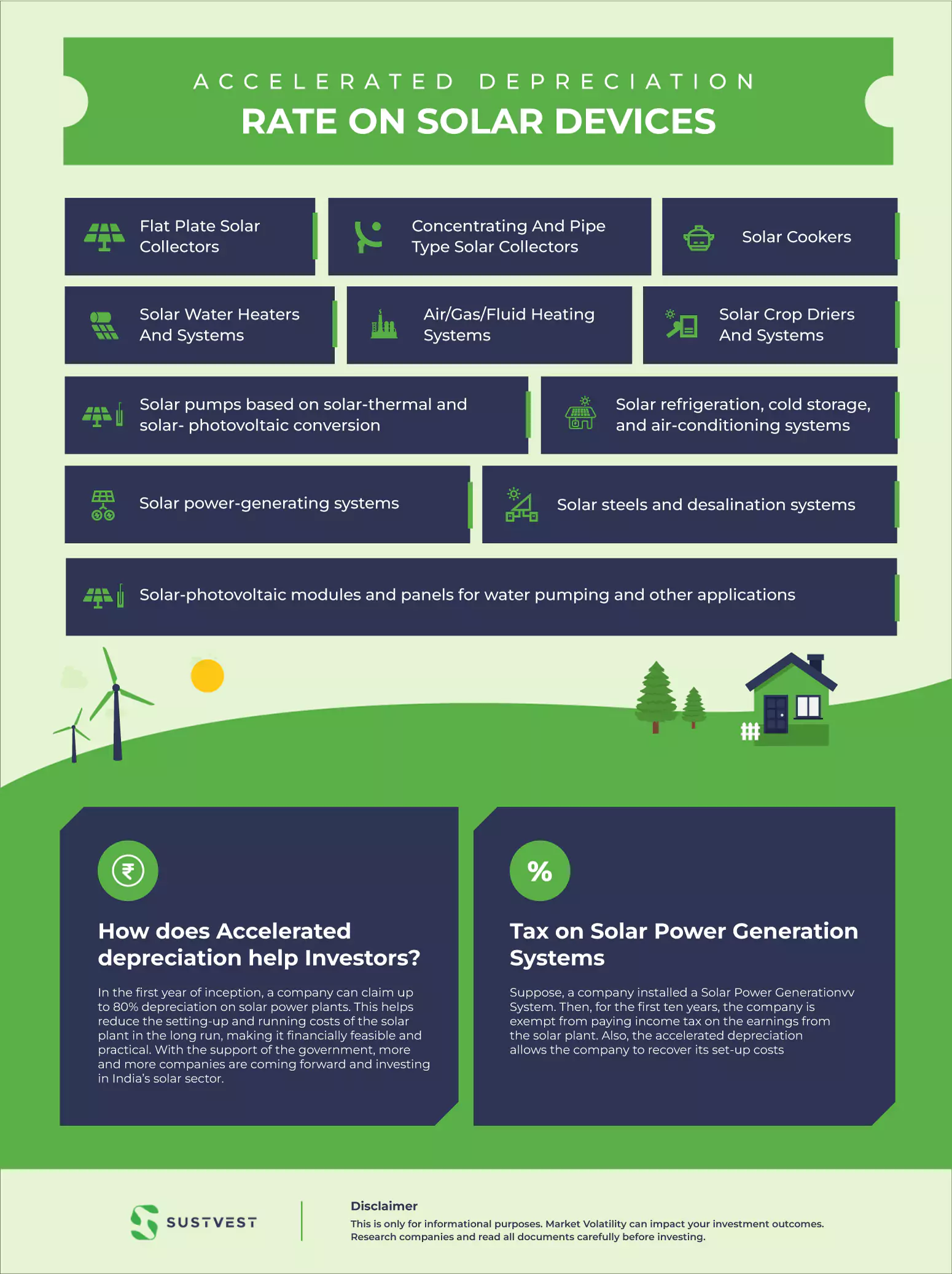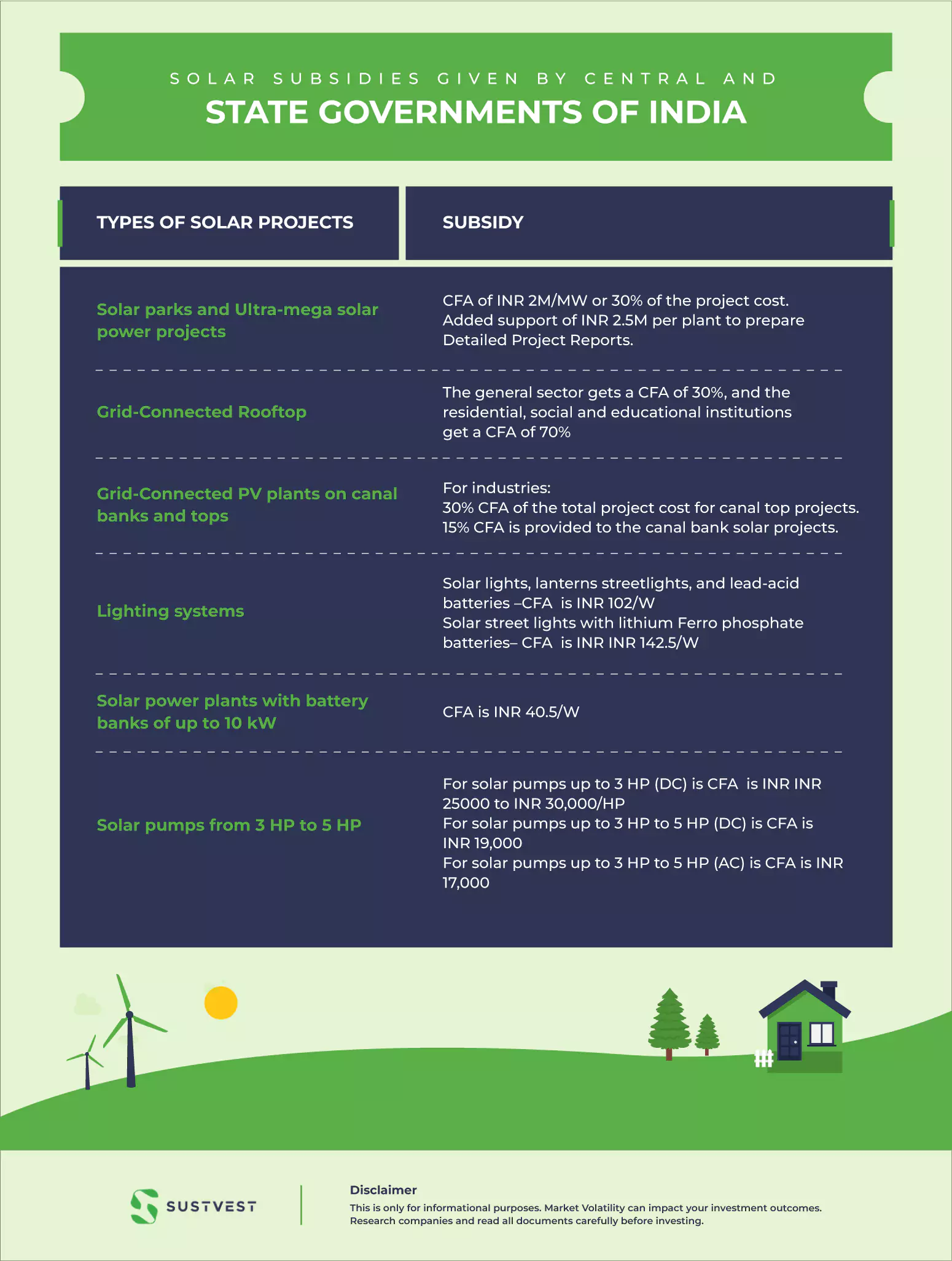India is aware of the geographical advantages it has to grow exponentially in the renewable energy sector, especially in solar and wind. The Indian government has left no stone unturned to bring in more investors and encourage consumers to use renewable energy.
For instance, currently, talks are going on to reduce the goods and services tax (GST) on solar devices from 12% to 5% and to also decrease the import duty on solar panels from 40% to 20%.
However, do you know about the tax exemption for solar power in India? Yes, the Indian government has introduced several sections like Section 80-IA of the Income Tax Act, 1961 to provide accelerated depreciation and GST exemptions on solar projects.
These tax exemptions implied on the green energy for installation, usage and commercial services can be claimed by firms and individuals irrespective of the capital involved.
Let’s see how tax exemption for solar power in India works.

Tax Exemption for Solar Power in India
As disclosed above, the Income Tax Act of 1961 provides Tax exemption for solar power under Section 80-IA. The exemptions are covered under accelerated depreciation.
Let’s first see the Accelerated depreciation rate of Solar Panels.
Accelerated depreciation rate on Solar Devices

A solar project has several components (tangible assets) in it: devices, battery storage, panels, etc. Accelerated depreciation (AD) helps investors recover their capital invested in setting up solar projects by claiming higher solar tax depreciation on the various assets.
The rates of depreciation for the solar are given in the tangible assets section, 3-Machinery and Plant, under subsection 8. The depreciation rate for renewable energy devices is granted at 40% of the cost that occurred for any device established in AY 2018-19 onwards. However, the depreciation allowance for AYs 2003 to 2019 was 80%.
Below are the renewable energy devices covered under Ssection 8 (from point 13 onwards) for more information –
(XIII) Renewal energy devices being—
(a) Flat plate solar collectors
(b) Concentrating and pipe-type solar collectors
(c) Solar cookers
(d) Solar water heaters and systems
(e) Air/gas/fluid heating systems
(f) Solar crop driers and systems
(g) Solar refrigeration, cold storage, and air-conditioning systems
(h) Solar steels and desalination systems
(i) Solar power-generating systems
(j) Solar pumps based on solar-thermal and solar-photovoltaic conversion
(k) Solar-photovoltaic modules and panels for water pumping and other applications
How does Accelerated depreciation help Investors?
In the first year of inception, a company can claim up to 80% depreciation on solar panels. This helps reduce the setting-up and running costs of the solar plant in the long run, making it financially feasible and practical. With the support of the government, more and more companies are coming forward and investing in India’s solar sector.
Tax on Solar Power Generation Systems
Suppose, a company installed a Solar Power Generation System. Then, for the first ten years, the company is exempt from paying income tax on the earnings from the solar plant. Also, the accelerated depreciation tax benefits allow the company to recover its set-up costs.
Let’s see the subsidies provided by the government to boost the solar sector.
Solar Subsidies Given by Central and State Governments of India

The Indian government’s Ministry of New and Renewable Energy (MNRE) has introduced various Central Financial Assistance (CFA) schemes to provide financial aid for both personal and commercial use.
Many states including Uttarakhand, Himachal Pradesh, Jammu & Kashmir, and Uttar Pradesh, get assistance of 70% installation cost from state governments and 30% assistance for installation cost for rooftop solar panel installations.
Schemes like Jawaharlal Nehru National Solar Mission (Phase II) under SECI help set up projects with viability gap funding support from the central government. The projects are selected based on bidding. Any developer can participate in the open tender process announced by SECI.
So, SECI provides funding support to the project developers involved in providing solar solutions for residential or personal purposes; say to a social association.
To ease up the process, you can avail yourself of the services of solar solution providers like Sustvest and benefit from solar energy through a PPA model or RESCO model of SECI. Under this, rooftop solar owners can use electricity and pay for it at a pre-decided monthly tariff plan. The excess electricity can be sold to the grid supplier/DISCOM for monetary benefits.
See the subsidies provided for different types of solar projects below.
| Types of Solar Projects | Subsidy |
| Solar parks and Ultra-mega solar power projects | CFA of INR 2M/MW or 30% of the project cost. Added support of INR 2.5M per plant to prepare Detailed Project Reports. |
| Grid-Connected Rooftop | The general sector gets a CFA of 30%, and the residential, social and educational institutions get a CFA of 70%. |
| Grid-Connected PV plants on canal banks and tops | For industries: 30% CFA of the total project cost for canal top projects. 15% CFA is provided to the canal bank solar projects. |
| Lighting systems | Solar lights, lanterns streetlights, and lead-acid batteries –CFA is INR 102/W Solar street lights with lithium Ferro phosphate batteries– CFA is INR INR 142.5/W |
| Solar power plants with battery banks of up to 10 kW | CFA is INR 40.5/W |
| Solar pumps from 3 HP to 5 HP | For solar pumps up to 3 HP (DC) is CFA is INR INR 25000 to INR 30,000/HP For solar pumps up to 3 HP to 5 HP (DC) is CFA is INR 19,000 For solar pumps up to 3 HP to 5 HP (AC) is CFA is INR 17,000 |
Benefits of Subsidies and Tax Exemption for Solar Power in India
- The tax exemption has helped solar energy solution providers recover from the initial bulk investment in projects. It has encouraged solar developers to innovate various solar energy solution models for small to large energy consumption opportunities, in the commercial as well as residential sectors.
- The first 10 years of any solar energy generating plant are free from tax. This has encouraged more people to invest in solar projects. Investing once and then reaping benefits for more than 25 years is a solid investment for any bidder.
- The subsidy for grid connectivity projects and net metering has made solar installation possible even in places with space constraints, irrespective of their APL or BPL status. It has brought the perks of enjoying free electricity to commercial and residential sectors.
- The Central Financial Assistance and State financial assistance provided to the solar energy projects are helping the overall infrastructural development of the nation. Also, it is helping India achieve its solar installation target.
- Moreover, tax exemptions and subsidies are encouraging Indian companies to boost the solar energy sector by providing cost-effective locally-made solar products. Invest India has initiated several schemes to support Indian-origin green energy companies through subsidies, bank loans, and tax benefits.
- The overall cost of electricity generated from any solar projects after the tax exemptions is considerably less, giving cheaper electricity to consumers. It helps reduce the overall production or running costs of several companies, houses, and commercial and community complexes.
FAQs: Tax Exemption for Solar Power in India
Can individuals claim tax exemption on their personal investments in renewable energy projects?
No, an individual can not claim tax exemption for solar power in India. It is only available to companies investing in green projects. However, to claim it you need to buy solar solutions from a third party like SustVest through a PPA agreement.
How much tax exemption can be claimed under the Accelerated Depreciation policy?
Any company can claim an accelerated depreciation of 40% in the first year of its inception. After that, 20% AD can be claimed on the total cost of the project.
Is solar power exempt from GST?
No, solar power is not exempt from GST. It is charged at a rate of 12% as goods and 5% as a service.
Is there any subsidy for solar energy in India?
Yes, the Indian government provides subsidies for domestic, social, and educational usage, but not for commercial production. The subsidy varies for different types of solar projects, and the amount is decided by the state and central governments. The average subsidy ranges between 40 to 90% of the total project cost.
Conclusion
Tax exemption for solar power in India has been the most important factor pushing the momentum of India’s growth in the renewable energy sector. It has opened doors for both industrial reforms and at the regional level. With the benefits like subsidies and tax deductions, both investors and consumers are receiving financial gains.
Tax exemption and solar panel depreciation rate scheme has cut down the cost of installing and generating power from solar devices in the initial stage as well. The future looks even more promising when the government will reduce the GST rates back to 5% from 12% as of now, and the import duty as well.
These present years are a promising time for investing in renewable energy solar projects. For a hassle-free investment experience in solar projects, visit SustVest, an online investment platform providing solar solutions to various companies, and real estate, residential, and educational bodies.

Founder of Sustvest
Hardik completed his B.Tech from BITS Pilani. Keeping the current global scenario, the growth of renewable energy in mind, and people looking for investment opportunities in mind he founded SustVest ( formerly, Solar Grid X ) in 2018. This venture led him to achieve the ‘Emerging Fintech Talent of the Year in MENA region ‘ in October 2019.




